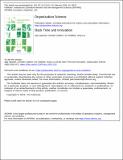| dc.contributor.author | Goldfarb, Avi | |
| dc.contributor.author | Agrawal, Ajay K | |
| dc.contributor.author | Catalini, Christian | |
| dc.contributor.author | Luo, Hong | |
| dc.date.accessioned | 2019-03-07T12:47:48Z | |
| dc.date.available | 2019-03-07T12:47:48Z | |
| dc.date.issued | 2018-12 | |
| dc.date.submitted | 2018-02 | |
| dc.identifier.issn | 1047-7039 | |
| dc.identifier.issn | 1526-5455 | |
| dc.identifier.uri | http://hdl.handle.net/1721.1/120770 | |
| dc.description.abstract | The relationship between slack resources and innovation is complex, with the literature linking slack to both breakthrough innovations and resource misallocation. We reconcile these conflicting views by focusing on a novel mechanism: the role slack time plays in the endogenous allocation of time and effort to innovative projects. We develop a theoretical model that distinguishes between periods of high- (work weeks) versus low- (break weeks) opportunity costs of time. Low-opportunity cost time during break weeks may induce (1) lower quality ideas to be developed (a selection effect); (2) more effort to be applied for any given idea quality (an effort effect); and (3) an increase in the use of teams because scheduling is less constrained (a coordination effect). As a result, the effect of an increase in slack time on innovative outcomes is ambiguous, because the selection effect may induce more low-quality ideas, whereas the effort and coordination effect may lead to more high-quality, complex ideas. We test this framework using data on college breaks and on 165,410 Kickstarter projects across the United States. Consistent with our predictions, during university breaks, more projects are posted in the focal regions, and the increase is largest for projects of either very high or very low quality. Furthermore, projects posted during breaks are more complex, and involve larger teams with diverse skills. We discuss the implications for the design of policies on slack time. | en_US |
| dc.publisher | Institute for Operations Research and the Management Sciences (INFORMS) | en_US |
| dc.relation.isversionof | http://dx.doi.org/10.1287/orsc.2018.1215 | en_US |
| dc.rights | Creative Commons Attribution 4.0 International license | en_US |
| dc.rights.uri | https://creativecommons.org/licenses/by/4.0/ | en_US |
| dc.source | INFORMS | en_US |
| dc.title | Slack Time and Innovation | en_US |
| dc.type | Article | en_US |
| dc.identifier.citation | Agrawal, Ajay, Christian Catalini, Avi Goldfarb, and Hong Luo. “Slack Time and Innovation.” Organization Science 29, no. 6 (December 2018): 1056–1073. | en_US |
| dc.contributor.department | Sloan School of Management | en_US |
| dc.contributor.mitauthor | Agrawal, Ajay K | |
| dc.contributor.mitauthor | Catalini, Christian | |
| dc.contributor.mitauthor | Luo, Hong | |
| dc.relation.journal | Organization Science | en_US |
| dc.eprint.version | Final published version | en_US |
| dc.type.uri | http://purl.org/eprint/type/JournalArticle | en_US |
| eprint.status | http://purl.org/eprint/status/PeerReviewed | en_US |
| dc.date.updated | 2019-02-01T16:08:06Z | |
| dspace.orderedauthors | Agrawal, Ajay; Catalini, Christian; Goldfarb, Avi; Luo, Hong | en_US |
| dspace.embargo.terms | N | en_US |
| dc.identifier.orcid | https://orcid.org/0000-0003-1312-6705 | |
| mit.license | PUBLISHER_CC | en_US |
